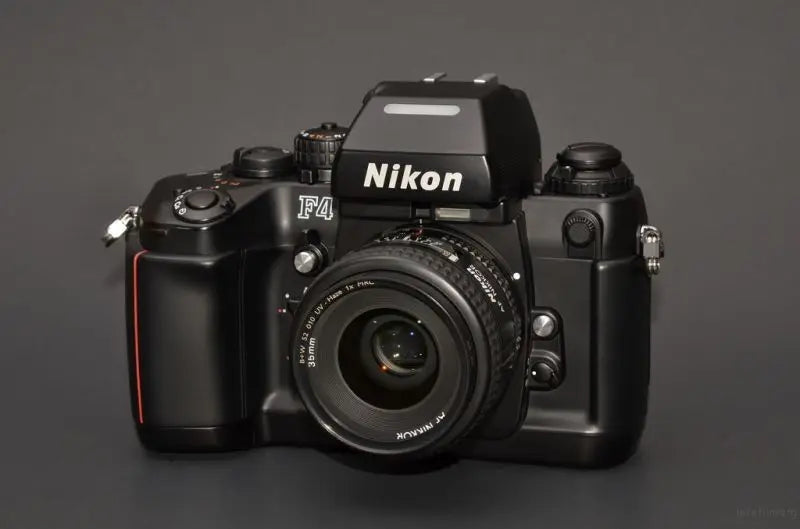
Legend and decline of Nikon F4 professional film SLR camera
Nikon F4 is in an awkward position. As a professional flagship, it is not as popular as F3 and F5, or even F100. The reason is that people who like manual cameras feel that it is not as traditional as F3, and those who like automatic cameras feel that it is not as fast as F5 or F100. That's all right. Now I want to talk about the advantages of F4 over F3 and F5 and the reasons for choosing F4.
Let's compare with F3 first. What F3 can do, F4 can do more and better:
(1) some people say that F4's manual focusing is not as convenient as F3's, because ordinary F4 is configured with a B-type focus screen designed for automatic focusing, and there is no split image focusing function. However, F4 can replace 13 kinds of focus screens, of which the K-shaped split focus screen is the same as or even brighter than the K-shaped focus screen of F3, which is designed for manual focusing. After changing to K screen, F4's manual focusing ability is no worse than F3's. F4 is Nikon's only autofocus SLR with a k-screen. Other autofocus SLRs (n8008, N90, F100, F5, F6) do not have a k-screen.
(2) F4 can accept all manual lenses that F3 can accept, including non AI (i.e., auto and k-head), AI and AIS, and F4 can also use matrix metering when using AI / AIS lenses. Of course, if it is an AF head, F4 can also focus automatically. The following two figures are the information about F4 lens matching in the Nikon F4 user manual.


Note that both AI and AIS manual lenses for F4 can be used for matrix photometry as AF lenses, but the modified AI lens cannot be used for matrix photometry.
(3) F3 is smaller than F4. Most F4s with mb-21 handle (6 batteries) become F4s, which is almost the same size as F3 with MD-4 film winder. If F4 does not have mb-21 and only has mb-20 (4 batteries), it is not too big compared with F3 without MD-4. F4 has more handles, and the benefits of these handles are very great (grip, automatic film winding and continuous shooting, etc.).
(4) F3 looks more classical than F4, which is certain. Everyone has a good appearance, which can't be changed.
(5) Other functions: 1 / 8000 second shutter speed (F3 only has 1 / 2000), 1 / 250 second flash synchronization speed (F3 only has 1 / 80 seconds), speed priority and program exposure mode, matrix and spot metering, etc., which F3 does not have. Of course, auto focus, although not fast, is better than F3. In short, in addition to the subjective indicator of appearance, F4 comprehensively surpasses F3.
Then compare with F5. F5 is definitely better than F4, mainly in terms of auto focus, photometry, and continuous shooting speed, which is much better than F4, while other improvements are not so critical. The advantages of F4 over F5 are: (1) the ordinary F4 with mb-20 (not F4s) is much smaller than F5, and the base of F5 cannot be disassembled. (2) F4 accepts more lenses than F5. F4 can accept almost all lenses (non AI head needs to shrink the aperture to measure light; G head can only be in P and s positions), while F5 can't accept non AI head (auto and K head). (3) F4 can use AI / AIS lens to measure light in matrix, while F5 can only measure light in central weight with these manual heads. (4) All functions of F4 can be obtained directly through traditional knobs or buttons, while F5 needs to be obtained through "menu".
F100 can be regarded as a simplified F5 without a base, but it is not so strong. After all, F100 is not the flagship. Today, people prefer F100 to F4, mainly because F100 is more advanced and light than F4. But when it comes to playability, F4 is better than F100.
Nikon F4 was launched in 1988, which caused great repercussions in the photography industry. At that time, even professional photographers had to wait patiently for several months to buy F4. Ken Rockwell said that F2 is only an improvement of F, and F3 is only an electronic F2. They are all progress rather than breakthrough. Only F4 is a breakthrough compared with F3. It is the world's first professional automatic focusing machine, the first professional built-in motor machine, and the first professional matrix (intelligent) photometric machine. F5, F6, digital cameras, and even D3 are not as seismic as F4. Indeed, F, F2, and F3 all look like similar traditional shapes, and F4 has begun to modernize.
The most popular version of F4 is F4s (with mb-21, 6 batteries), followed by F4 (with mb-20, 4 batteries), followed by f4e (with mb-23, 6 batteries).
F4 was originally produced in 1988 (serial number started from 2000001), and the last batch was produced in 1996 (serial number 26xxxxx). To collect F4, you should try to choose the one with the highest serial number. This is because Nikon has made a series of improvements to F4 after it came into the market, including externally visible ones (such as shutter speed, dial handwriting clarity, coating firmness, and the height and strength of release lock; photometric mode selection switch on viewfinder; viewfinder disassembly method; a small piece protrudes above the handle; the "kr-aa" at the lower left of mb-21 becomes "Ni Cd", etc.), And what is invisible inside (body metal reinforcement, etc.). The last improvement is that a small hole is added to the flash hot shoe to lock the sb-25 / sb-26 flash, which can only be seen on F4 after the serial number 2500000. Of course, these are not very big changes. Even the early F4 is very reliable. The second choice of mobile phones mainly depends on the condition. A common aging problem is the LCD bleed of the viewfinder, so you should carefully check it when you buy it.
When purchasing F4s, you must pay attention to the matching of various parts. For example, a body with a serial number of 25xxxxx and a viewfinder with no holes in the hot boots are not the original ones; The fuselage with the serial number of 24xxxxx is equipped with a flat and concave handle, or a "kr-aa" mb-21, which also indicates that it was patched up later. Although there is no difference in use, there is no collection value.



Nikon F4 is an outdated flagship. Even if it is outdated, it will still be the flagship. Isn't the film machine outdated?

The above picture is one of the best cameras in 1991 recommended by the American magazine "popular photography" in December 1990. The last sentence is: because Nikon F4s is in short supply, even professional photographers have to wait patiently for their extended orders, and often close to the catalog price! Is it worth it? The owner's answer is: of course. (the catalog price chart at that time showed $2427.57).


1 comment
Refinements to the F4
The F4 has undergone many upgrades since its introduction in 1988. Some of these may affect operation. Those with serial numbers from 2350000 include most of these modifications. Your F4 may or may not have the following features:
1. The metering system selector switch is stiffer and sticks out less to prevent unintentional changes.
2. The metal body is somewhat stronger, which cannot be detected visually.
3. The shutter speed numbers on the original F4s rubbed and flaked off, later models don’t exhibit this tendency.
4. The standard prism of later models (serial numbers 2200000 and higher) has a two-step security lock to prevent its accidental removal (for instance if a Speedlight is attached, creating additional torque).
5. The prism in later models (serial numbers 2500000 and higher) has an extra hole in the hot shoe to accommodate the security pin of the SB-25, SB-26, SB-27, and SB-28 flash units.
6. The grip has more contour, and a small rubber “tooth” has been added, which sticks out in the grip to support the user’s middle finger. This provides more support and a more secure feeling for your right hand.
7. Early models have a pin made of metal to detect whether the back is open or not. The pins in later models are made out of white plastic. (Check if purchasing an F4 secondhand; metal pins can stick in humid weather.)
8. The battery switch inside later models of the MB-21 grip is labeled “Ni-Cd” instead of “KR-AA.”
9. The exterior plastic was changed from a semi-gloss to a matte finish for better “gripability.”
10. Earlier models (serial numbers 2350000 and lower) have a higher battery voltage threshold, shortening the life of most batteries. This can be reprogrammed when serviced.
11. The exposure compensation dial is stiffer to make it harder to move it accidentally.
12. AE-L and AF-L lever has a stronger spring catch.